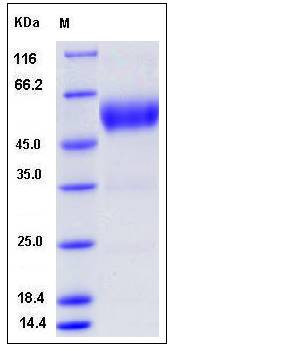Human SCN3B Protein (Fc Tag)
ATFB16,BRGDA7,HSA243396,SCNB3
- 100ug (NPP4247) Please inquiry
| Catalog Number | P13500-H02H |
|---|---|
| Organism Species | Human |
| Host | Human Cells |
| Synonyms | ATFB16,BRGDA7,HSA243396,SCNB3 |
| Molecular Weight | The recombinant human SCN3B/Fc is a disulfide-linked homodimeric protein. The reduced monomer consists of 378 amino acids and has a predicted molecular mass of 42.5 kDa. The apparent molecular mass of the reduced monomer is approximately 50-55 kDa in SDS-PAGE under reducing conditions due to glycosylation. |
| predicted N | Phe 23 |
| SDS-PAGE |  |
| Purity | > 96 % as determined by SDS-PAGE |
| Protein Construction | A DNA sequence encoding the human SCN3B (Q9NY72) extracellular domain (Met 1-Glu 159) was fused with the Fc region of human IgG1 at the C-terminus. |
| Bio-activity | |
| Research Area | Cancer |Signal transduction |Signaling Pathway |Representative pathway |p53 pathway |
| Formulation | Lyophilized from sterile PBS, pH 7.4 1. Normally 5 % - 8 % trehalose and mannitol are added as protectants before lyophilization. Specific concentrations are included in the hardcopy of COA. |
| Background | SCN3B (sodium channel, voltage-gated, type III, beta ,human IgG1-Fc chimera) belongs to the sodium channel auxiliary subunit SCN3B family. It contains 1 Ig-like C2-type (immunoglobulin-like) domain. Voltage-gated sodium channels are transmembrane glycoprotein complexes composed of a large alpha subunit and one or more regulatory beta subunits. They are responsible for the generation and propagation of action potentials in neurons and muscle. SCN3B gene encodes one member of the sodium channel beta subunit gene family, and influences the inactivation kinetics of the sodium channel. Two alternatively spliced variants, encoding the same protein, have been identified. Defects in SCN3B are the cause of Brugada syndrome type 7. A tachyarrhythmia characterized by right bundle branch block and ST segment elevation on an electrocardiogram. It can cause the ventricles to beat so fast that the blood is prevented from circulating efficiently in the body. When this situation occurs (called ventricular fibrillation), the individual will faint and may die in a few minutes if the heart is not reset. |
| Reference |
